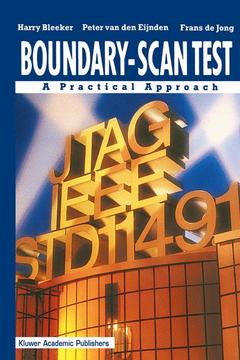Description
Boundary-Scan Test, 1993
A Practical Approach
Authors: Bleeker Harry, van den Eijnden Peter, de Jong Frans
Language: English
Subject for Boundary-Scan Test:
Keywords
Hardware; Signal; Standard; complexity; integrated circuit; production; stability
Approximative price 158.24 €
In Print (Delivery period: 15 days).
Add to cart
Publication date: 10-2012
225 p. · 15.5x23.5 cm · Paperback
225 p. · 15.5x23.5 cm · Paperback
Description
/li>Contents
/li>Comment
/li>
The ever-increasing miniaturization of digital electronic components is hampering the conventional testing of Printed Circuit Boards (PCBs) by means of bed-of-nails fixtures. Basically this is caused by the very high scale of integration of ICs, through which packages with hundreds of pins at very small pitches of down to a fraction of a millimetre, have become available. As a consequence the trace distances between the copper tracks on a printed circuit board cmne down to the same value. Not only the required small physical dimensions of the test nails have made conventional testing unfeasible, but also the complexity to provide test signals for the many hundreds of test nails has grown out of limits. Therefore a new board test methodology had to be invented. Following the evolution in the IC test technology. Boundary-Scan testing hm; become the new approach to PCB testing. By taking precautions in the design of the IC (design for testability), testing on PCB level can be simplified 10 a great extent. This condition has been essential for the success of the introduction of Boundary-Sc,m Test (BST) at board level.
List of Figures. Preface. 1. PCB Testing. 2. The Boundary-Scan Test Standard. 3. Hardware Test Innovations. 4. BST Design Languages. 5. PCB Test Strategy Backgrounds. 6. Management Aspects. Appendix. Glossary. References. Index.
'I recommend this book for the following audience in the field of digital design: advanced undergraduate and graduate students, who are interested in testing digital systems and are looking for an up-to-date course in design for testability, practising engineers interested in incorporating modern techniques for improving testability into their designs, and design managers who are looking for ways to improve factory profitability and return on investments. The book will appeal especially to practising VLSI and ASIC designers, and I recommend it to them highly.'Engineering Applications of Artifical Intelligence, 7:1' In summary, this text is a useful and readable description of the application and use of boundary-scan. It is also a useful addition to previous boundary-scan publication, and complementary to more recent. I thoroughly recommend this book. ' Microprocessors and Microsystems 17:5 1993
© 2024 LAVOISIER S.A.S.
These books may interest you

The Boundary-Scan Handbook 52.74 €

IDDQ Testing of VLSI Circuits 105.49 €


